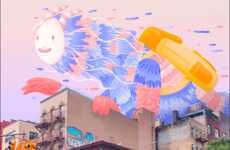
Zirofax Illustrates Aquatic Creatures with Lovecraftian Look
Jason Soy — May 21, 2012 — Art & Design
References: zirofax.deviantart & ufunk.net
Staring at the cover image of this Zirofax gallery, it’s natural to be reminded of the works of H.P. Lovecraft. After all, whenever anyone encounters a creature with an octopus-like head and tentacles on its face, they instinctually think of Cthulhu. Continue browsing Zirofax’s work, however, and you’ll realize that she’s not a one trick pony, as she’s rendered several humanoid creatures all with deep sea animal attributes. The results are wholly satisfying fantasy illustrations that are simultaneously gross and beautiful.
Zirofax, who also likes calling herself “The Goblin Queen,” is an American artist with deviant tastes. Many of the pieces found in her portfolio contain bizarre anatomical elements. It’s not uncommon to see claws, fangs, feathers and fins in her dazzling illustrations.
Zirofax, who also likes calling herself “The Goblin Queen,” is an American artist with deviant tastes. Many of the pieces found in her portfolio contain bizarre anatomical elements. It’s not uncommon to see claws, fangs, feathers and fins in her dazzling illustrations.
Trend Themes
1. Aquatic Creature Depictions - Artists can explore depictions of deep sea humanoid creatures that incorporate aspects of marine life, potentially inspiring new creatures in fantasy and science fiction genres.
2. Combining Human and Animalistic Features - By combining human and animalistic features through illustration, artists can create provocative, thought-provoking fantasy pieces that push boundaries.
3. Lovecraftian Inspired Art - Inspiring art that draws on H.P. Lovecraft's work to create grotesque and unnerving creature images is becoming more popular among artists looking to expand on the genre of horror and dark fantasy.
Industry Implications
1. Fantasy Art - Professional artists could leverage the trend of aquatic and sea creature inspired humanoid depictions to broaden their clientele and expand the types of characters they're commissioned to create.
2. Publishing - Publishers of fantasy and science fiction literature could benefit from the aesthetic appeal and popularity of Lovecraftian and aquatic creature inspired art by using it in book covers and illustrations for novels and short stories within those genres.
3. Gaming - Game designers can take inspiration from fantasy art trends and begin to create games with deep sea humanoid characters that include aspects of marine biology, opening up new avenues for exploration in underwater settings within game narratives.
3.5
Score
Popularity
Activity
Freshness























